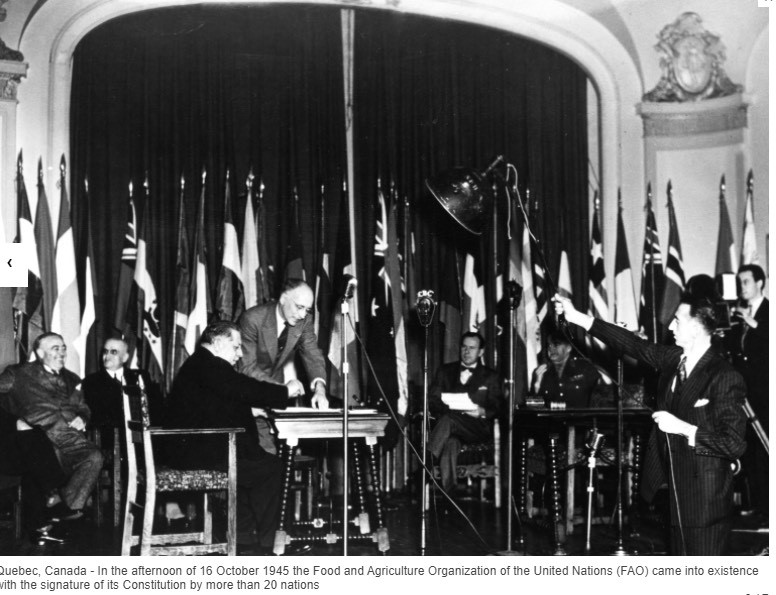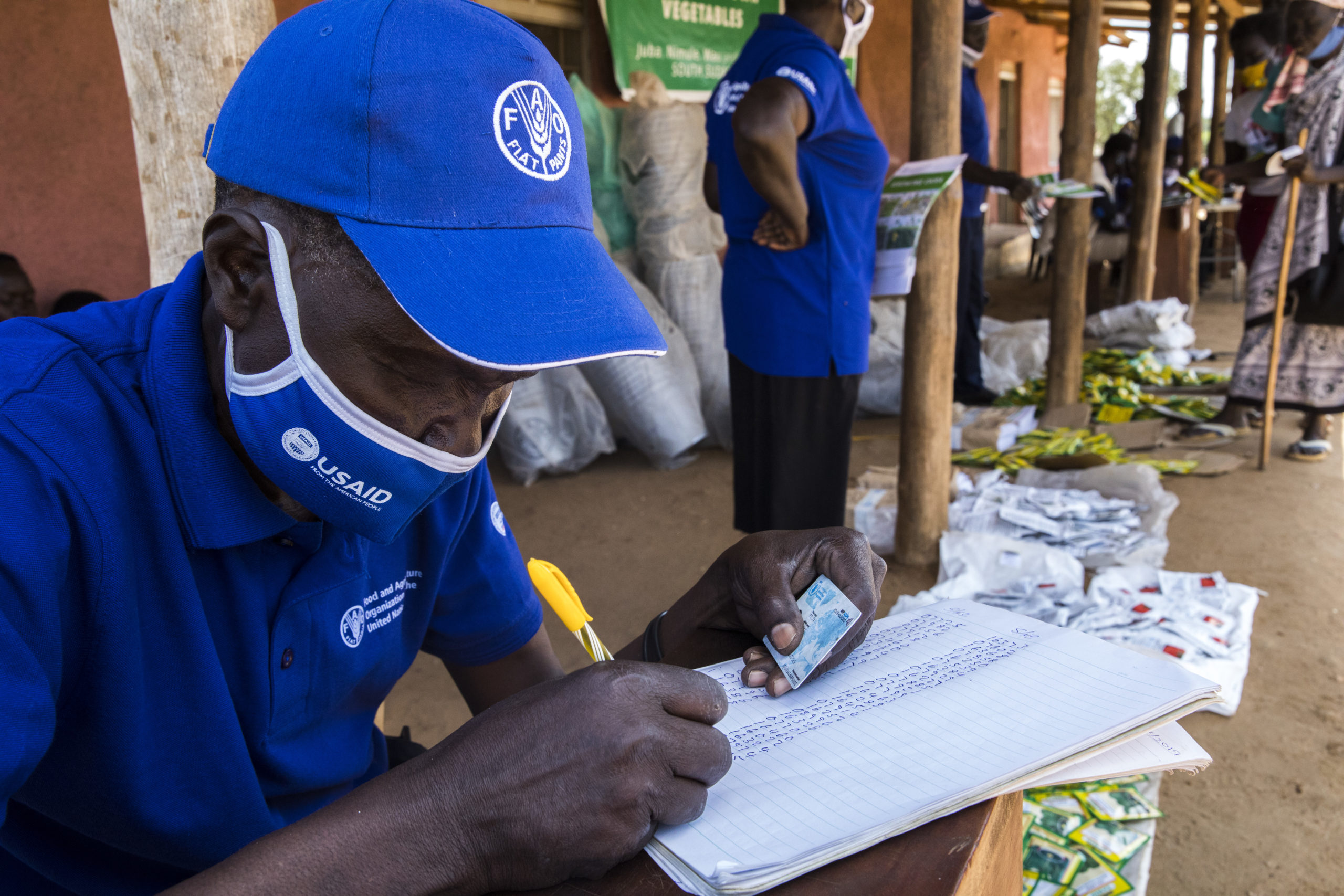Celebrating FAO’s 75th Anniversary: A Historical Account
It was May of 1943 in Hot Springs, Virginia at the Homestead Hotel. World War II was still raging. President Franklin D. Roosevelt invited 44 nations to the United Nations Conference on Food and Agriculture. This historical and ultimately very influential meeting has a backstory.
At the time, the phrase “United Nations”, coined by President Roosevelt in 1942, referred to the 26 nation Governments who pledged to continue fighting together against the Axis Powers.[1] It was a moment of vast destruction, polarization and hunger for people across the world. Famine was claiming lives alongside the war, and food systems were disrupted globally.
World War II had brought the intergovernmental work of the International Institute of Agriculture (IIA) to a standstill. The IIA, established in June 1905 by 40 country ministers at Villa Borghese in Rome, had been the first international intergovernmental organization to deal with the problems of agriculture, and the linkages of health, food and nutrition.
While the coordinated efforts of the IIA were lost amidst the chaos of the war, the relevance of its work was not. Frank L. McDougall and Stanley Bruce of Australia, among many, had not lost sight of the vital importance of linking the great, unsatisfied need for highly nutritious food, human health and the immense potential for modern agriculture production. They developed this idea of the “United Nations Conference on Food and Agriculture” in a Draft Memorandum on a United Nations Programme for Freedom from Want of Food.
Entering the stage, U.S. First Lady Eleanor Roosevelt, taking great interest in this draft memorandum, met with McDougall, and set about bringing it to the President’s attention. Soon after, McDougall was dining with President Roosevelt and a small group at the White House. McDougall mentioned to the President that, while the United Nations were thus far held together by the exigencies of war, once the war was over, they would need some common problems upon which to work if their cooperation was to continue. Food was certainly a common problem for all.
A newspaper announcement in early Spring 1943 stated President Roosevelt was inviting governments to participate in a United Nations Conference on Food and Agriculture in Hot Springs, Virginia. The 44 Nation representatives assembled for this meeting ultimately establishing an Interim Commission entrusted with formulating “a specific plan for a permanent organization in the field of food and agriculture.” Based on a collation of recommendations that foreshadowed the core concepts for the “permanent organization,” the Commission drafted a Constitution for the Food and Agriculture Organization of the United Nations (FAO). The Hon. Lester B. Pearson of Canada served as the Chairman of the Interim Commission.
The First Session of the FAO Conference was held in the Chateau Frontenac at Quebec, Canada. On 16 October 1945, 42 nations signed the Constitution, creating FAO as a specialized agency of the United Nations.[2] Washington D.C. served as the temporary FAO headquarters until the agency moved to Rome in 1951.

In the preamble of the FAO constitution, the founding members created the Organization to help them raise levels of nutrition and standards of living, secure improvements in the efficiency of production and distribution of food and agricultural products, and to better the condition of rural populations.
This recall of history lends important reflection for the moment we are currently experiencing, further emphasizing the critical need to cooperate amidst evolving challenges to ensure we can all meet our basic needs for regular access to enough high-quality food to lead active, healthy lives while sustaining and stewarding the planet- the foundation of our very own existence.
In the 75 years since the founding of FAO, the world has made great strides in reducing food insecurity, alleviating poverty and improving nutrition globally. Agricultural productivity and agri-food systems have come a long way. Our approaches have evolved with tremendous advancements in technologies, science, innovations, data collection and analysis capabilities, partnerships and policies for a human-rights based approach. Today, Indigenous peoples’ rights and food systems, gender-equity, climate resilience and nutrition are cross-cutting issues in all sectors. Despite all this, we find ourselves again in a moment of global reckoning.
Yet today, nearly 700 million people still face hunger while more than 2 billion people lack access to safe and nutritious foods, and up to 3 billion people cannot afford a healthy diet. Economic disparities, environmental degradation, compounding impacts of climate change and extreme weather events, infestations, loss of biodiversity, food loss and waste, human rights violations and poor working conditions for agricultural workers continue to be persistent issues.
The COVID-19 pandemic has added to and compounded these challenges. Food insecurity has been a harsh reality for more people during this health crisis. The economic disruption linked to the pandemic may push another 130 million people into hunger by the end of the year. This current moment reminds us that food security and nutritious diets matter to all, and there are billions of people involved in making such food accessible.
With the theme “Grow, nourish, sustain. Together. Our actions are our future”, this year’s World Food Day calls for more resilient and robust agri-food systems, and for global solidarity – both vital for our recovery from this crisis, and for building back better. More than ever, we need innovative solutions and strong partnerships.
Everyone has a role to play in ensuring nutritious food is available for all – from governments, researchers, producers, businesses, organizations to individuals.
On World Food Day 2020, I hope you will join me in reflecting on the founding of FAO, noting that it was truly a historical moment for the countries of the world and for agriculture and food. FAO alongside all the UN bodies, Member States and partnering stakeholders remain unwavering in our commitment to achieving the 2030 Agenda and the Sustainable Development Goals. We have an essential Decade of Action ahead of us.
Together let us Grow, Nourish and Sustain. Our future depends on it.
Photos are courtesy of FAO.




